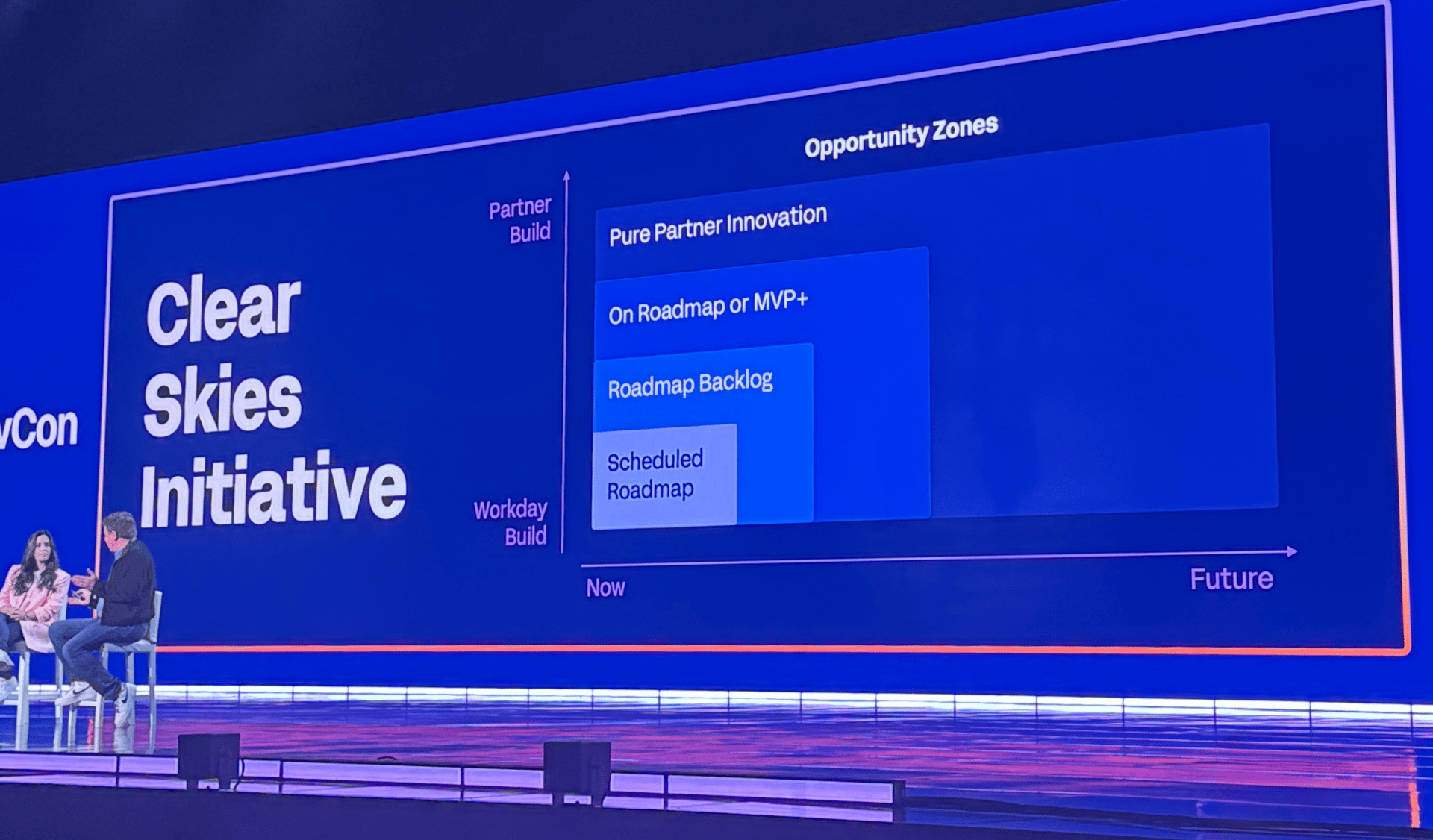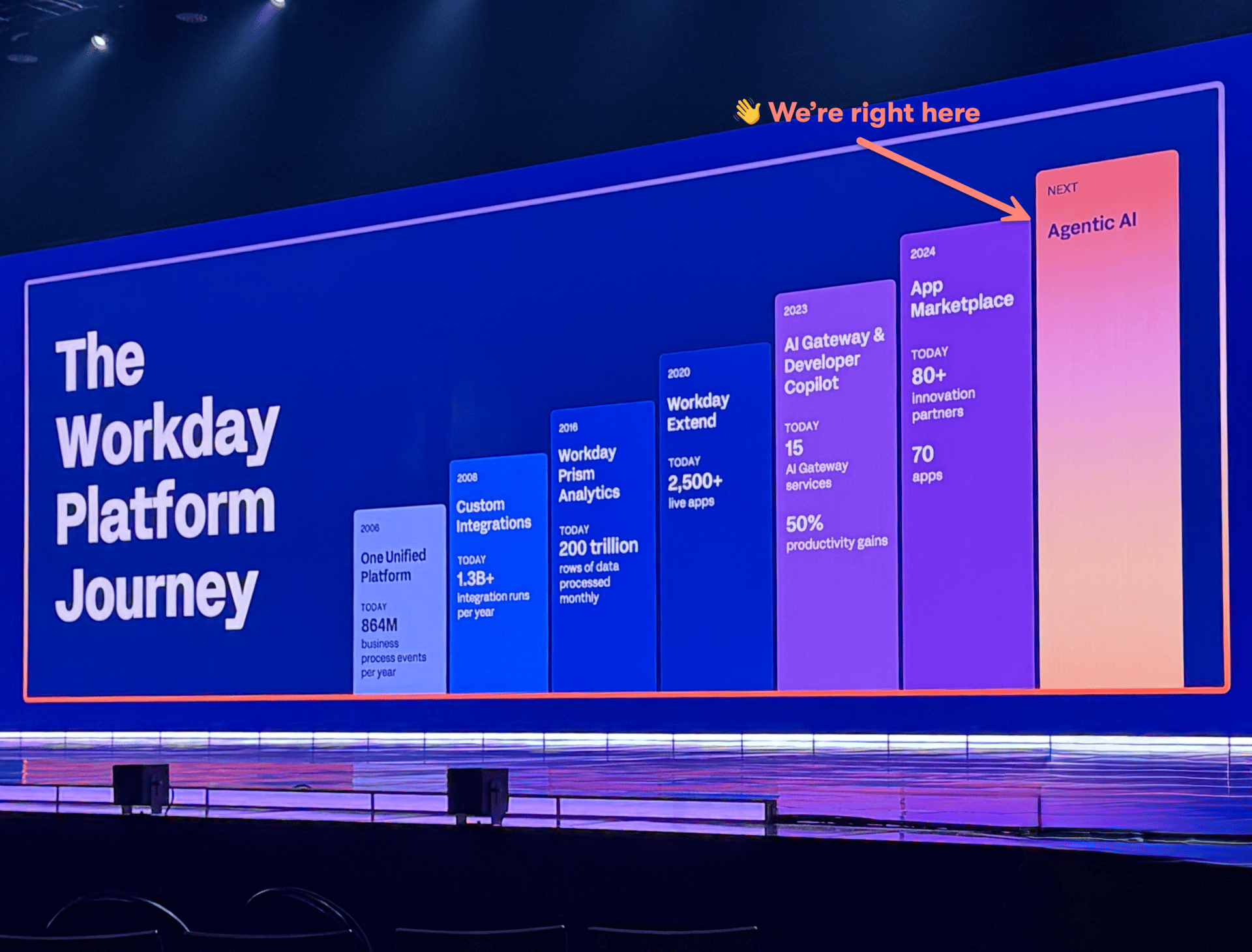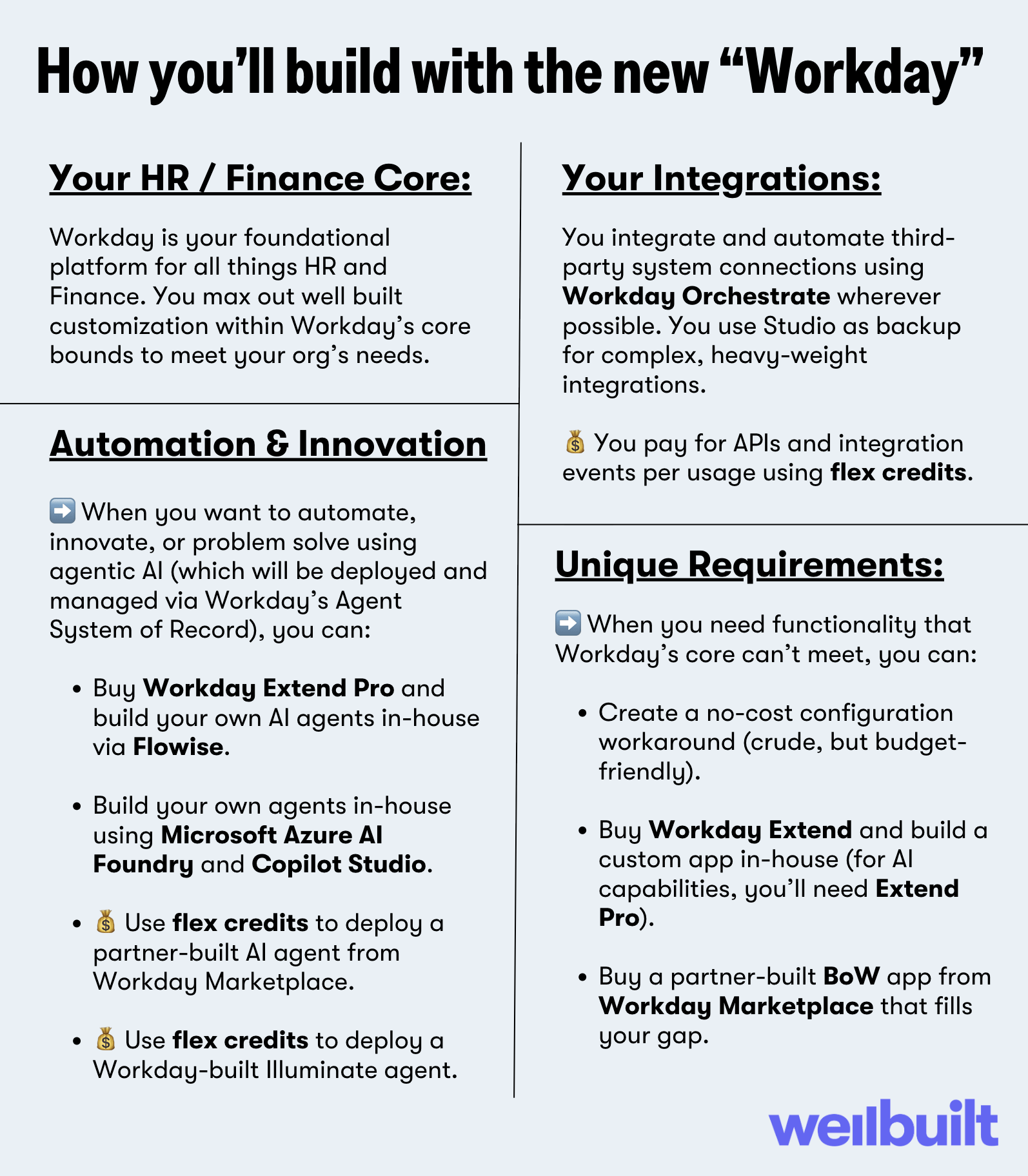- The Well Built Solutions Newsletter
- Posts
- Somewhere in between here and there
Somewhere in between here and there
What's happening in the Workday world?
Read time: 10 minutes
Hey there! Mia and Ceci here (after a brief hiatus from your inbox!).
The annual double-whammy cocktail crash of Workday Rising immediately followed by the final Workday Release of the year has always been chaotic.
And this year? Certainly no exception.
In fact, we’d argue that Workday’s onslaught of announcements over the course of Rising made this September the Workday world’s wildest month ever.
Workday blasted the ecosystem with AI everything—agents, gateways, credits, partnerships, acquisitions.
If you felt equal parts inspired and overwhelmed after Rising… same 😵💫
So, we took a few weeks to digest it all, and do what we do best: Research, learn, and then… share our findings with you 🤗
In today’s newsletter, we’re back to demystify what the heck is happening in the Workday world right now.
Let’s dive in 🌊
📣 Did ya hear?!
Last month, we launched Well Built Library 📚
The first of its kind, on-demand, Workday knowledge transfer engine that turns your team into strategic, self-sufficient problem solvers. So you and your team can maximize your ROI with Workday 👏
If your team has the Workday Learning module, you’re a candidate!
Book a call with us to learn more and see a sampler here 😎
Workday’s next wave: AI-powered open platform
Rising in one sentence: Workday is entering its AI-powered open platform era.
What does that mean? 🤔 Let’s start with a ‘lil Workday history…
Earning platform status
Workday began as a closed HR and Financials SaaS product. Meaning, you paid for a Workday subscription, did your best to connect your other critical systems to it, and that’s it. All customization happened within the confines of WD-delivered functionality. As of now, this is still the case for many customers (albeit, integration capabilities have expanded a ton since Workday’s early days).
For nearly 15 years, Workday worked its way toward becoming a platform (i.e., something that enables others to build or operate on top of it).
When Workday Extend meaningfully entered the scene around 2020 (we shared our thoughts on Extend back in June after getting certified ourselves), Workday’s platform era humbly began. With Extend, for the first time, customers and partners could build custom apps that “extend” Workday’s native functionality.
Over the past five years, Workday has grown its Extend sub-ecosystem, including its developer community and partner network. There are now over 130 apps by 50+ different partners for sale on Workday Marketplace, and Workday plans to take those numbers beyond 300 apps and 130 partners in 2026. Each app fills a specific capability gap or solves a niche business problem for Workday customers.
Check out this chart from Workday DevCon this past May…

📸 Workday DevCon, May 2025
Over time, Workday will pass the baton to its partners. Partners will play a bigger and bigger role in building, and ultimately evolving, the technology that runs on the Workday platform.
And it turns out apps aren’t the only thing partners will be building…
🤖 AI overload…
A hefty chunk of Workday’s Rising announcements centered on ✨ Agentic AI ✨

📸 Also Workday DevCon, May 2025
Earlier this year, Workday announced Agent System of Record (ASOR—gosh, we just can’t resist a good acronym here in ERP land, can we 🙃), and unveiled its first handful of Workday Illuminate AI Agents.
💡 “Workday Illuminate” is Workday’s branding bucket for all AI functionality across its platform (including agents). Basically, anything AI-related that Workday builds in-house gets the Illuminate label.
So… Workday imagines a future where your org employs dozens if not hundreds of specialized AI agents that each handle a specific role or set of tasks. ASOR is the centralized command center where that digital workforce will live. That is, a hub from which you’ll deploy, manage, and track all of your enterprise AI agents.
Now your next Qs might be, how will you “hire” and “pay” this digital workforce? 🤔
At Rising (and in the months leading up to it), Workday made a slew of announcements that begin to answer these questions. Here’s what the landscape looks like so far…
Building your digital workforce…
You’ll have 3 ways to get AI agents:
Buy from a Partner on Workday Marketplace
Build your own
Buy from Workday (dedicated newsletter allll about this coming soon 👀)
Here’s what got announced at Rising within each of these avenues…
📣 Buy agents from a partner off Marketplace
🤖 Enter, the Workday Agent Partner Network (WAPN—also an official WD acronym, we swear 😬). Selected partners can build agents that plug into ASOR. Big guys like Accenture, Adobe, Amazon Web Services, Deloitte, Glean, Google Cloud, Microsoft, and PwC are among the first in the program. If you’re familiar with your Extend options, WAPN is the BoW of agents.
🤖 Agent Gateway. The tech that enables partner-built agents to plug into ASOR and have their agents communicate with their fellow agent colleagues. For now, ASOR and Agent Gateway are only available to a select set of Early Adopter customers and partners. General availability is tentatively planned for March 2026.
📣 Build your own agents in-house
🤖 Workday acquired Flowise. Okay, so this actually happened a month before Rising 🤭, but it’s worth mentioning here to give you the full low-down on Workday’s big moves in the enterprise agent arms race. After acquiring Flowise—a visual / low-code agent builder platform—in August, at Rising, Workday announced Workday Flowise Agent Builder. In terms of availability, only Workday Extend Pro customers will get access to this nifty tool to build their own agents in first half of 2026. The limited availability is a bummer. Ideally, Workday ends up offering Flowise as a SKU, or better yet, makes it generally available.
🤖 A Workday 🤝 Microsoft partnership. With ASOR’s integration with Microsoft Entra Agent ID, Workday customers will be able to build AI agents using Microsoft Azure AI Foundry and Copilot Studio, and easily plug them into ASOR. This provides customers another way to build agents in-house.
📣 Buy agents from Workday
🤖 Workday announced the expansion of their own agent-presence, unveiling a handful of new Workday Illuminate Agents that’ll become available in 2026. There are now 13 Workday-built agents altogether (stay tuned for a complete breakdown soon 👀).
Paying for your digital workforce: Flex Credits 💰
Alright. Now to address a new elephant in the room… how will Workday price agents, along with other new AI capabilities? Enter, the next ginormous Rising announcement we need to talk about: Flex Credits.
Flex Credits are Workday’s new usage-based pricing solution. Soon, you’ll pay for APIs, integration events, document storage, and AI agents based on usage.
Here’s what we know so far:
You’ll get complimentary credits at the beginning of each year.
You can use all the tech you want in Sandbox without incurring any cost.
Credits expire at the end of the year (use it or lose it—e.g., if you buy 100 credits and only use 50, you’re not reimbursed, and those credits don’t roll over to next year).
Credits are fixed and non-refundable.
You can buy more credits anytime.
If your usage exceeds 5% of the annual credits you bought, you’ve got to pay those overages.
Credits are consumed based on each component’s individual rate, which is based on Workday’s estimated operating costs and your predicted value (🤔).
Partner-built agents also consume flex credits.
Marketplace apps are not bought with credits.
As a customer, you’ll get access to your very own Platform Consumption Console (PCC) where you can track your usage down to the component.
Flex credits are available for purchase today. If you migrate over to Workday’s new Universal Main Subscription Agreement (UMSA), which all customers are gonna have to sign eventually, you can start playing around with available components for free in SBX.
So, what will these costs actually look like? No clue, but we’re incredibly curious and will stay hot on the trail 🔥
📣 Workday Build
Workday’s clear direction is to empower customers and partners to build on its platform. Not only apps, but now also agents. At Rising, they announced Workday Build (not to be confused with the Built on Workday program)—basically a giant bucket of all the developer tools available to help Workday customers and partners “build” on top of and into Workday.
Most of the other big Rising announcements, including all the agentic AI stuff we just covered, are bucketed within Workday Build.
Now remember when we said “AI-powered open platform”? Well here’s the announcement that opened the door for that “open” part…
🛠️ Workday Data Cloud
At Rising, Workday also announced Workday Data Cloud: A partnership with Databricks, Salesforce, and Snowflake to create real-time, two-way sharing of customer data between Workday and these other enterprise systems.
TLDR: Through an Apache Iceberg integration (quickly becoming the backbone of modern data sharing), Workday’s data lives securely in Workday, but you’ll also be able to access it from Databricks, Salesforce, and Snowflake, and vice versa. Data updated in one system is updated across all 4 systems, instantly. This is called zero-copy sharing. This and other capabilities of Workday Data Cloud will enable a whole new world of reporting and real-time insights, surfacing answers to questions like:
Which skills gaps are slowing down our most profitable initiatives? Workday (skills cloud, job data) + Snowflake (project metrics, ticket throughput) + Salesforce (deal cycle length).
Does higher employee engagement correlate to customer satisfaction or revenue growth? Blend Workday (engagement survey results, turnover) + Salesforce (CSAT scores, renewal rates).
Where should we hire next to actually move the needle? Workday (open reqs, workforce plans) + Salesforce (regional growth pipeline) + Databricks (market potential).
This partnership is likely just the tip of the Iceberg (nerdy pun intended 😉) in terms of data sharing. With 4 enterprise giants kicking it off, we anticipate the “openness” will only expand.
Workday Data Cloud will be available to early adopters in the first half of 2026, and generally available later that year.
And one more big AI announcement…
This earthquake of an announcement came at the tail end of Rising. Workday spent $1.1 billion to acquire Sana—an AI-powered learning platform. Sana is already posted on Workday Marketplace as a stand-alone LMS solution that can also integrate with Workday HCM and Learning. In the nearish-term, this acquisition could make Learning one of Workday’s sexiest SKUs 💃🏻 Longterm, it could change Workday’s user-interface entirely, taking Workday from bolted on AI layer to true AI-powered platform. TBD! We’ll see what the future holds 🔮
“The new work day” ➡️ The new Workday
The energy behind all of these announcements was palpable in CEO Carl Eschenbach’s Rising keynote. With an emboldened tone of “we’re just getting started!”, he welcomed us all to “the new work day” (i.e., the new Workday). Times truly are a-changin’! We’re living through the AI revolution, and Workday is making serious moves to lead how this revolution reshapes work at the enterprise level.
We made the graphic below to make sense of it all so far (and sum up your suite of options in this developing landscape)…

Stay tuned 👀
Today, we covered what is happening. In a future newsletter, we’ll share our take on what all of this really means for Workday customers.
Are customers ready for the AI wave? What determines AI readiness? What will the challenges be? What’s the next best move to make with consideration of where your org is today? And, is the messaging of “AI-powered, human-centric, and future-ready” legitimate, or just more marketing gobbily-gook?
Where have we been!?
A quick personal update. We’ve been gone from your inbox for a month and we MISSED writing to you 😭
Here’s what was happening over here…
✅ We announced the launch of Well Built Library—the culmination of nearly 18 months of work! This happened live on a virtual Workday block party of over 600 people (if ya missed it, you can ▶️ watch the replay here).
✅ Had our first handful of HRIS teams become WBL Founding Members 🤩 🎉 (if you want to join the crew, book a call with us).
✅ Flew to San Francisco to attend the super bowl of IRL Workday events, Workday Rising. Spent 3 days connecting with wonderful humans (including many of you! 😍), whilst surviving info/sensory overload of course.

✅ Workday announced an onslaught of exciting acquisitions, partnerships, and emerging technology. We went into deeeeep research mode 🔍
✅ The 2025R2 release hit Production tenants.
✅ Ceci got ENGAGED in Napa Valley fresh off of Workday Rising 💍
As always, thank you for being a reader!
We’re celebrating you and your pursuit of a Well Built Workday 🥳
Until next time!
Mia & Ceci
Co-Founders of Well Built Solutions
P.S. Loving the newsletter? Leave us a testimonial here 🥰

Say hi 👋 on LinkedIn — @ceciblomberg, @miaeisenhandler
📚 Learn more about Well Built Library | Book a call | See a sample
▶️ Watch the replay from the first-ever Well Built Webinar
🤝 Want to partner? Get on Well Built’s project waitlist here
Reply